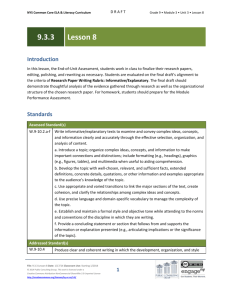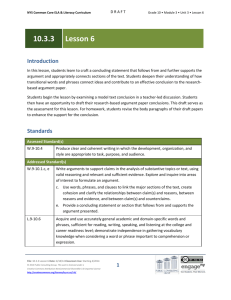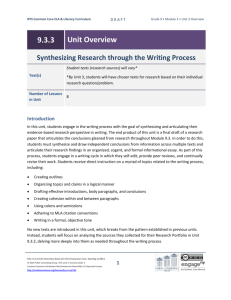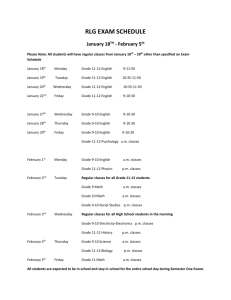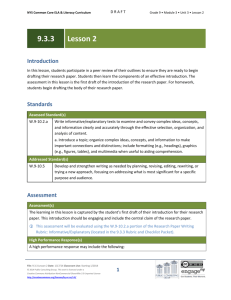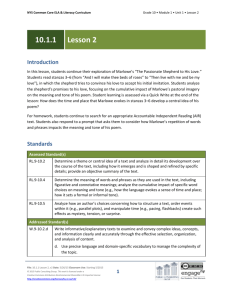109.52 KB - EngageNY
advertisement
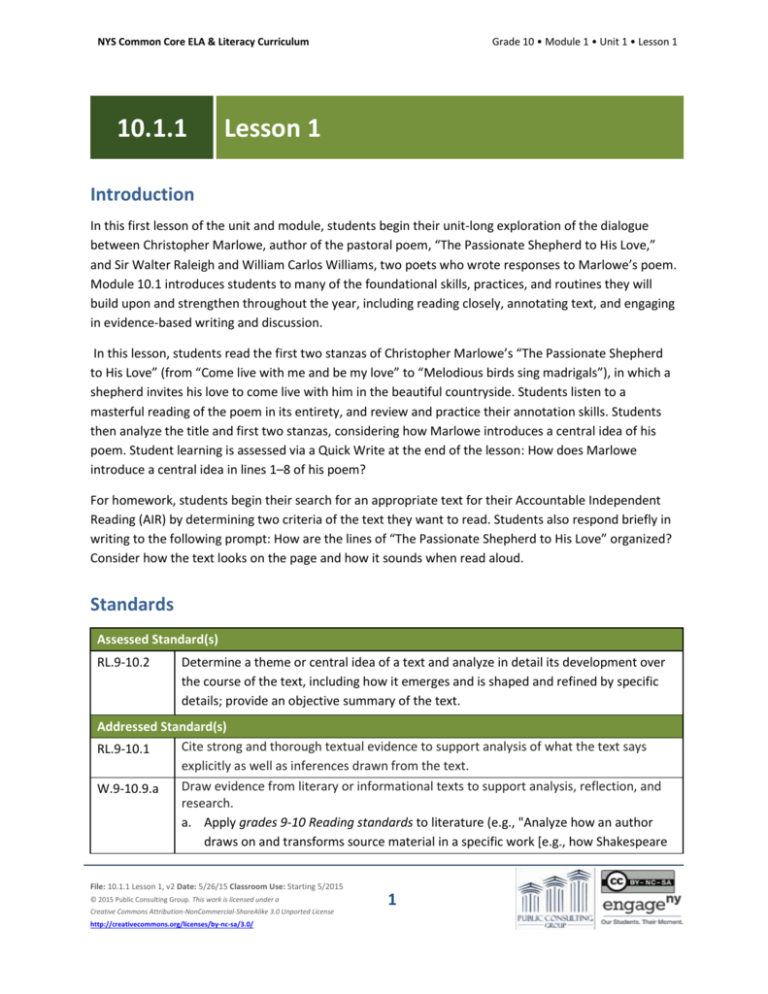
NYS Common Core ELA & Literacy Curriculum 10.1.1 Grade 10 • Module 1 • Unit 1 • Lesson 1 Lesson 1 Introduction In this first lesson of the unit and module, students begin their unit-long exploration of the dialogue between Christopher Marlowe, author of the pastoral poem, “The Passionate Shepherd to His Love,” and Sir Walter Raleigh and William Carlos Williams, two poets who wrote responses to Marlowe’s poem. Module 10.1 introduces students to many of the foundational skills, practices, and routines they will build upon and strengthen throughout the year, including reading closely, annotating text, and engaging in evidence-based writing and discussion. In this lesson, students read the first two stanzas of Christopher Marlowe’s “The Passionate Shepherd to His Love” (from “Come live with me and be my love” to “Melodious birds sing madrigals”), in which a shepherd invites his love to come live with him in the beautiful countryside. Students listen to a masterful reading of the poem in its entirety, and review and practice their annotation skills. Students then analyze the title and first two stanzas, considering how Marlowe introduces a central idea of his poem. Student learning is assessed via a Quick Write at the end of the lesson: How does Marlowe introduce a central idea in lines 1–8 of his poem? For homework, students begin their search for an appropriate text for their Accountable Independent Reading (AIR) by determining two criteria of the text they want to read. Students also respond briefly in writing to the following prompt: How are the lines of “The Passionate Shepherd to His Love” organized? Consider how the text looks on the page and how it sounds when read aloud. Standards Assessed Standard(s) RL.9-10.2 Determine a theme or central idea of a text and analyze in detail its development over the course of the text, including how it emerges and is shaped and refined by specific details; provide an objective summary of the text. Addressed Standard(s) Cite strong and thorough textual evidence to support analysis of what the text says RL.9-10.1 explicitly as well as inferences drawn from the text. Draw evidence from literary or informational texts to support analysis, reflection, and W.9-10.9.a research. a. Apply grades 9-10 Reading standards to literature (e.g., "Analyze how an author draws on and transforms source material in a specific work [e.g., how Shakespeare File: 10.1.1 Lesson 1, v2 Date: 5/26/15 Classroom Use: Starting 5/2015 © 2015 Public Consulting Group. This work is licensed under a Creative Commons Attribution-NonCommercial-ShareAlike 3.0 Unported License http://creativecommons.org/licenses/by-nc-sa/3.0/ 1 NYS Common Core ELA & Literacy Curriculum Grade 10 • Module 1 • Unit 1 • Lesson 1 treats a theme or topic from Ovid or the Bible or how a later author draws on a play by Shakespeare]"). L.9-10.4.a Determine or clarify the meaning of unknown and multiple-meaning words and phrases based on grades 9–10 reading and content, choosing flexibly from a range of strategies. a. Use context (e.g., the overall meaning of a sentence, paragraph, or text; a word’s position or function in a sentence) as a clue to the meaning of a word or phrase. Assessment Assessment(s) Student learning is assessed via a Quick Write at the end of the lesson. Students respond to the following prompt, citing textual evidence to support analysis and inferences drawn from the text. How does Marlowe introduce a central idea in lines 1–8 of his poem? Throughout this unit, Quick Writes will be assessed using the Short Response Rubric. High Performance Response(s) A High Performance Response should: Identify a central idea in lines 1–8 (e.g., the relationship between humans and nature). Analyze how Marlowe introduces this central idea (e.g., Marlowe introduces the central idea of the relationship between humans and nature in lines 1–8 of his poem by establishing a connection between the speaker’s relationship with his love and the natural world. In order to convince his “love” to accept his invitation to “live with” him (line 1), the shepherd promises his love various “pleasures” (line 2), or enjoyments, found in nature, such as listening to “[m]elodious” bird song (line 8). Through the shepherd’s persuasive description of the wonders that await his love if she joins him in the countryside, Marlowe creates an connection between the beauty of the natural world and the shepherd’s “passionate” feelings towards his love.). Vocabulary Vocabulary to provide directly (will not include extended instruction) prove (v.) – to learn or find out by experience steepy (adj.) – steep yields (v.) – bears or brings forth as a natural product especially as a result of cultivation Vocabulary to teach (may include direct word work and/or questions) madrigals (n.) – songs for several singers without instruments that were popular in the sixteenth File: 10.1.1 Lesson 1, v2 Date: 5/26/15 Classroom Use: Starting 5/2015 © 2015 Public Consulting Group. This work is licensed under a Creative Commons Attribution-NonCommercial-ShareAlike 3.0 Unported License http://creativecommons.org/licenses/by-nc-sa/3.0/ 2 NYS Common Core ELA & Literacy Curriculum Grade 10 • Module 1 • Unit 1 • Lesson 1 and seventeenth centuries Additional vocabulary to support English Language Learners (to provide directly) melodious (adj.) – having or making a pleasant musical sound Lesson Agenda/Overview Student-Facing Agenda % of Lesson Standards & Text: Standards: RL.9-10.2, RL.9-10.1, W.9-10.9.a, L.9-10.4.a Text: “The Passionate Shepherd to His Love” by Christopher Marlowe, stanzas 1– 2 Learning Sequence: 1. 2. 3. 4. 5. 6. Introduction of Lesson Agenda Masterful Reading Introduction to Annotation Reading and Discussion Quick Write Closing 1. 2. 3. 4. 5. 6. 15% 5% 20% 35% 15% 10% Materials Copies of the 10.1 Common Core Learning Standards Tool for each student Copies of “The Passionate Shepherd to His Love” for each student Free Audio Resource: http://librivox.org/the-passionate-shepherd-to-his-love-by-christophermarlowe-2/ Copies of the Short Response Rubric and Checklist for each student Learning Sequence How to Use the Learning Sequence Symbol Type of Text & Interpretation of the Symbol 10% no symbol Percentage indicates the percentage of lesson time each activity should take. Plain text indicates teacher action. Bold text indicates questions for the teacher to ask students. File: 10.1.1 Lesson 1, v2 Date: 5/26/15 Classroom Use: Starting 5/2015 © 2015 Public Consulting Group. This work is licensed under a Creative Commons Attribution-NonCommercial-ShareAlike 3.0 Unported License http://creativecommons.org/licenses/by-nc-sa/3.0/ 3 NYS Common Core ELA & Literacy Curriculum Grade 10 • Module 1 • Unit 1 • Lesson 1 Italicized text indicates a vocabulary word. Indicates student action(s). Indicates possible student response(s) to teacher questions. Indicates instructional notes for the teacher. Activity 1: Introduction of Lesson Agenda 15% Begin by outlining the goals for this module and unit. Explain to students that the first module of the year focuses on developing their ability to read closely and to use evidence from what they read in their writing and discussions. The focus of this unit is to introduce these skills in an exploration of the conversation among three poets, Christopher Marlowe, Sir Walter Raleigh, and William Carlos Williams. This conversation emerges in response to Marlowe’s poem “The Passionate Shepherd to His Love.” Review the agenda and the assessed standard for this lesson: RL.9-10.2. In this lesson, students develop their close reading skills as they begin their exploration of Christopher Marlowe’s poem “The Passionate Shepherd to His Love.” Students consider how Marlowe introduces a central idea of his poem, and then complete the lesson with a Quick Write. Since this is the first day of the curriculum, it may be necessary to begin establishing yearlong procedures and protocols. This first module establishes some expectations regarding pair work, group work, and evidence-based discussion. It is important to take time to set up these routines. Students look at the agenda. Distribute copies of the 10.1 Common Core Learning Standards Tool. Explain that students will work throughout the year to master the skills described in the Common Core State Standards (CCSS). Inform students that in this lesson they begin to work with four new standards: RL.9-10.1, RL.9-10.2, W.910.9.a, and L.9-10.4.a. Instruct students to individually read these standards on their tools and assess their familiarity with and mastery of each standard. Students read and assess their familiarity with standards RL.9-10.1, RL.9-10.2, W.9-10.9.a, L.910.4.a. Instruct students to talk in pairs about what they think RL.9-10.1 means. Lead a brief discussion about the standard. Student responses may include: o o Students use quotes from the text to explain what the text means. Students determine what the text says both directly and indirectly by reading between the lines. File: 10.1.1 Lesson 1, v2 Date: 5/26/15 Classroom Use: Starting 5/2015 © 2015 Public Consulting Group. This work is licensed under a Creative Commons Attribution-NonCommercial-ShareAlike 3.0 Unported License http://creativecommons.org/licenses/by-nc-sa/3.0/ 4 NYS Common Core ELA & Literacy Curriculum o Grade 10 • Module 1 • Unit 1 • Lesson 1 Students identify where things are unexplained or unclear in the text. Instruct students to talk in pairs about what they think RL.9-10.2 means. Lead a brief discussion about the standard. Student responses may include: o o o o This standard is about identifying a theme or central idea. This standard is about analyzing how an idea develops over the course of the text. Students analyze how specific details contribute to the development of an idea. Students summarize the text. Instruct students to talk in pairs about what they think L.9-10.4.a means. Lead a brief discussion about the standard. Student responses may include: o o The standard is about determining the meaning of words as they are used in a text. The substandard L.9-10.4.a focuses on using context clues to determine the meaning of unknown words, rather than a dictionary. Instruct students to talk in pairs about what they think W.9-10.9 and W.9-10.9.a mean. Lead a brief discussion about the standards. Student responses may include: o o Standard W.9-10.9 asks students to use evidence from fiction and nonfiction texts to support their ideas in writing. The substandard W.9-10.9.a asks students to use evidence from fiction texts to support analysis of literature using standards for reading literature. Activity 2: Masterful Reading 5% Distribute copies of “The Passionate Shepherd to His Love.” Have students listen to a masterful reading of the poem in its entirety (from “Come live with me and be my love” to “Then live with me and be my love”). Students follow along, reading silently. Consider using the following free audio resource: http://librivox.org/the-passionate-shepherd-tohis-love-by-christopher-marlowe-2/ Differentiation Consideration: Consider posting or projecting the following guiding question to support students in their reading throughout this lesson: File: 10.1.1 Lesson 1, v2 Date: 5/26/15 Classroom Use: Starting 5/2015 © 2015 Public Consulting Group. This work is licensed under a Creative Commons Attribution-NonCommercial-ShareAlike 3.0 Unported License http://creativecommons.org/licenses/by-nc-sa/3.0/ 5 NYS Common Core ELA & Literacy Curriculum Grade 10 • Module 1 • Unit 1 • Lesson 1 Which words and phrases help you to understand what the speaker of the poem wants? Activity 3: Introduction to Annotation 20% Discuss the importance of annotation by asking students the following questions: Why might a reader mark the text? Student responses may include: o o o o Marking the text helps a reader to record and remember important thoughts and ideas that they have while reading. Marking the text helps a reader to identify and think further about unfamiliar words. Marking the text helps a reader to make and record connections between ideas in a text, or between texts. Marking the text helps a reader to identify places in a text that raise questions, or that encourage deeper exploration. How might annotation impact the way you read and write? Student responses may include: o o Marking the text helps encourages more active and thorough reading through close consideration of details of the text, rather than skimming the text. Marking the text helps a writer to strengthen their writing by identifying strong and thorough textual evidence to support their analysis of a text. Explain that readers use shorthand to make notes or commentary on a text as they read so as to record their own thinking about the text without taking time away from their reading. Consider noting the relationship between annotation and standards W.9-10.9.a and RL.9-10.1: annotation helps students to look closely at textual evidence and use this evidence to support their written analyses. Display and explain the following annotation codes: Box unfamiliar words. Star (*) important or repeating ideas. Put a question mark (?) next to a section you are questioning or confused about, and write your question down. Use an exclamation point (!) for connections between ideas or ideas that strike or surprise you in some way, and provide a brief note or explanation. File: 10.1.1 Lesson 1, v2 Date: 5/26/15 Classroom Use: Starting 5/2015 © 2015 Public Consulting Group. This work is licensed under a Creative Commons Attribution-NonCommercial-ShareAlike 3.0 Unported License http://creativecommons.org/licenses/by-nc-sa/3.0/ 6 NYS Common Core ELA & Literacy Curriculum Grade 10 • Module 1 • Unit 1 • Lesson 1 Explain that it is important for students to annotate their text with their thoughts alongside the codes. Explain that students will use these codes throughout the year to record their thinking about the texts they read. To help students remember annotation codes, consider posting them in the classroom, or instructing students to copy the codes into their notebooks or agendas. Instruct students to read the whole poem, lines 1–24 (from “Come live with me and be my love” to “Then live with me and be my love”) and annotate the text according to the protocols established above. Consider having students listen to a second masterful reading before they read and annotate the poem. Student annotations may include the following: o o o o A question mark near “And we will all the pleasures prove” (line 2). Prove seems to mean something different here than “show” or “illustrate.” What does prove mean in this context? Boxes around unfamiliar vocabulary like kirtle (line 11) and myrtle (line 12). A star near the lines “If these delights thy mind may move, / Then live with me and be my love” (lines 23–24). These two lines seem to summarize what the speaker wants, and how he thinks he can persuade the listener. Exclamation points connecting the repetition of the phrase “live with me and by my love” in lines 1 (“Come live with me and be my love”), 20 (“Come live with me, and be my love”), and 24 (“Then live with me and be my love”). This annotation exercise supports students’ engagement with W.9-10.9.a, which addresses the use of textual evidence in writing. Lead a brief whole-class discussion of student annotations. Activity 4: Reading and Discussion 35% Instruct students to form small groups. Post or project each set of questions below for students to discuss. Instruct students to continue to annotate the text as they read and discuss. Instruct student groups to read lines 1–4 of “The Passionate Shepherd to His Love” (from “Come live with me and be my love” to “Woods, or steepy mountain yields”), and answer the following questions before sharing out with the class. File: 10.1.1 Lesson 1, v2 Date: 5/26/15 Classroom Use: Starting 5/2015 © 2015 Public Consulting Group. This work is licensed under a Creative Commons Attribution-NonCommercial-ShareAlike 3.0 Unported License http://creativecommons.org/licenses/by-nc-sa/3.0/ 7 NYS Common Core ELA & Literacy Curriculum Grade 10 • Module 1 • Unit 1 • Lesson 1 Provide students with the following definitions: prove means “to learn or find out by experience,“ steepy means “steep,” and yields means “bears or brings forth as a natural product especially as a result of cultivation.” Students may be familiar with some of these words. Consider asking students to volunteer definitions before providing them to the class. Students write the definitions of prove, steepy, and yields on their copies of the text or in a vocabulary journal. Consider the title of Marlowe’s poem. From whose point of view is this poem being told, and who is the intended audience? The “Shepherd” is the speaker of this poem, and the shepherd’s “love” is the intended audience. If necessary, explain to students that the speaker of a poem is like the narrator of a story. What does the speaker invite the listener to do? What does the speaker promise the listener in return? Student responses should include: o o The shepherd invites his love to “live with [him] and be [his] love” (line 1). The shepherd promises that if his love does as he asks, he will provide his love with the “pleasures” (line 2) of the “valleys, groves, hills, and fields” (line 3). What do the title and lines 1–4 of Marlowe’s poem suggest about the relationship between the speaker and his “love”? Student responses may include: o o o The shepherd is described as “passionate” in the title of Marlowe’s poem. This description suggests that the shepherd is trying to convince his “love” to be with him, or “live” with him (line 1), because he is desperately in love. The shepherd’s promise to reward his “love” with pleasures if his love comes to him suggests that his love is uncertain about living with him and needs to be persuaded by the shepherd. The fact that the shepherd invites his “love” to come be with him suggests that they are currently separated from each other. Lead a brief whole-class discussion of student responses. File: 10.1.1 Lesson 1, v2 Date: 5/26/15 Classroom Use: Starting 5/2015 © 2015 Public Consulting Group. This work is licensed under a Creative Commons Attribution-NonCommercial-ShareAlike 3.0 Unported License http://creativecommons.org/licenses/by-nc-sa/3.0/ 8 NYS Common Core ELA & Literacy Curriculum Grade 10 • Module 1 • Unit 1 • Lesson 1 Instruct student groups to read lines 5–8 (from “And we will sit upon the rocks” to “Melodious birds sing madrigals”) and answer the following questions before sharing out with the class. Differentiation Consideration: Consider providing students with the following definition: melodious means “having or making a pleasant musical sound.” Students write the definition of melodious on their copies of the text or in a vocabulary journal. According to the shepherd, if his love agrees, what pleasures will await them? If the shepherd’s love agrees to be with him, the shepherd promises that they will relax as they “sit upon the rocks” (line 5), amuse themselves by “[s]eeing the shepherds feed their flocks” (line 6), and enjoy listening to “[m]elodious birds sing madrigals” (line 8). Differentiation Consideration: If students struggle, consider asking the following scaffolding question: What context clues in line 8 can help you to determine what madrigals means? The words “melodious,” “birds,” and “sings” suggest that madrigals are a type of song (line 8). Consider drawing students’ attention to their application of L.9-10.4.a through the process of using context to determine the meaning of unknown words. From where will all the “pleasures” (line 2) come? What do all of these places have in common? Student responses should include: o o The pleasures will come from the “valleys,” “groves,” “hills,” “fields,” “[w]oods,” and “mountain” (lines 3–4). All of these places are outside; they are all part of nature. What connection does Marlowe develop in lines 1–8 between these “pleasures” (line 2) and the speaker’s relationship with his love? Marlowe establishes a connection between nature and in the shepherd’s romantic vision of living happily alongside the one he loves, because all of the “pleasures” (line 2) or enjoyments that the shepherd describes are found only in nature. Consider providing students with the phrase relationship between humans and nature to frame their discussion of the idyllic vision of life and love in the countryside that Marlowe constructs in his poem. This emerging idea of the relationship between humans and nature is central to Marlowe’s poem, and a common subject in the pastoral genre. Lead a brief whole-class discussion of student responses. File: 10.1.1 Lesson 1, v2 Date: 5/26/15 Classroom Use: Starting 5/2015 © 2015 Public Consulting Group. This work is licensed under a Creative Commons Attribution-NonCommercial-ShareAlike 3.0 Unported License http://creativecommons.org/licenses/by-nc-sa/3.0/ 9 NYS Common Core ELA & Literacy Curriculum Grade 10 • Module 1 • Unit 1 • Lesson 1 Activity 5: Quick Write 15% Distribute and introduce the Short Response Rubric and Checklist. Briefly explain the purpose of the rubric and checklist: to help students improve their Quick Write and reflective writing responses. Inform students that they should use the rubric and checklist to guide their own writing. Lead a brief discussion of the rubric and checklist categories: Inferences/Claims, Analyses, Evidence, and Conventions. Review the components of a high quality response. Quick Write activities continue to engage students in thinking deeply about texts, by encouraging them to synthesize the analysis they carry out during the lesson and build upon that analysis. Inform students that they typically have 4–10 minutes to write. Since this is the beginning of the school year, decide how best to collect, organize, and analyze assessments. This can be done through portfolios, journals, notebooks, etc., according to the needs of the classroom and students. Instruct students to keep their assessed Quick Writes for reference in future lessons assessments, unit assessments, and the Module Performance Assessment. Instruct students to respond briefly in writing to the following prompt: How does Marlowe introduce a central idea in lines 1–8 of his poem? Ask students to use this lesson’s vocabulary wherever possible in their written responses. Remind students to use the Short Response Rubric and Checklist to guide their written responses. Display the prompt for students to see, or provide the prompt in hard copy. Transition to the independent Quick Write. Students independently answer the prompt using evidence from the text. See the High Performance Response at the beginning of this lesson. Activity 6: Closing 10% Explain to students that part of the daily homework expectation is to read outside of class. Accountable Independent Reading (AIR) is an expectation that all students find, read, and respond to reading material written at their independent reading level. The purpose of AIR is to have students practice reading outside of the classroom and stimulate an interest and enjoyment of reading. Students listen. File: 10.1.1 Lesson 1, v2 Date: 5/26/15 Classroom Use: Starting 5/2015 © 2015 Public Consulting Group. This work is licensed under a Creative Commons Attribution-NonCommercial-ShareAlike 3.0 Unported License http://creativecommons.org/licenses/by-nc-sa/3.0/ 10 NYS Common Core ELA & Literacy Curriculum Grade 10 • Module 1 • Unit 1 • Lesson 1 AIR is an expectation for all students at all grade levels. AIR texts should be high interest but also a text that students can easily decode and comprehend. Give students several days to find an appropriate text. Explain to students that they must find an appropriate text for AIR. Provide suggestions for different places where students can look for texts, such as the local or school library, electronic books, classroom library, or home library. Students will have until 10.1.1 Lesson 5 to find an appropriate text. As the year progresses, students will be held accountable for their reading in a variety of ways. Students continue to listen. In addition to class discussions about AIR texts, consider other methods of holding students accountable. Ideas for accountability include reading logs, reading journals, posting to a class wiki, peer/teacher conferencing, and blogging. Display and distribute the homework assignment. For homework, students should begin looking for an appropriate text for their AIR by determining two criteria for the kind of text they want to read, e.g., topic, genre, fiction, or nonfiction. Additionally, for homework, instruct students to respond briefly in writing to the following prompt: How are the lines of “The Passionate Shepherd to His Love” organized? Consider how the text looks on the page and how it sounds when read aloud. Remind students to use the Short Response Rubric and Checklist to guide their responses. Students follow along. Homework Begin to look for an appropriate text to read for Accountable Independent Reading by determining two criteria for the text you want to read, e.g. topic, genre, fiction or nonfiction. In addition, respond briefly in writing to the following prompt: How are the lines of “The Passionate Shepherd to His Love” organized? Consider how the text looks on the page and how it sounds when read aloud. Use the Short Response Rubric and Checklist to guide your written response. File: 10.1.1 Lesson 1, v2 Date: 5/26/15 Classroom Use: Starting 5/2015 © 2015 Public Consulting Group. This work is licensed under a Creative Commons Attribution-NonCommercial-ShareAlike 3.0 Unported License http://creativecommons.org/licenses/by-nc-sa/3.0/ 11 NYS Common Core ELA & Literacy Curriculum Grade 10 • Module 1 • Unit 1 • Lesson 1 10.1 Common Core Learning Standards Tool College and Career Readiness Anchor Standards for Reading CCRA.R.6 Assess how point of view or purpose shapes the content and style of a text. CCRA.R.9 Analyze how two or more texts address similar themes or topics in order to build knowledge or to compare the approaches the authors take. CCS Standards: Reading—Literature RL.9-10.1 Cite strong and thorough textual evidence to support analysis of what the text says explicitly as well as inferences drawn from the text. RL.9-10.2 Determine a theme or central idea of a text and analyze in detail its development over the course of the text, including how it emerges and is shaped and refined by specific details; provide an objective summary of the text. I know what this is asking and I can do this. This standard has familiar language, but I haven’t mastered it. I am not familiar with this standard. I know what this is asking and I can do this. This standard has familiar language, but I haven’t mastered it. I am not familiar with this standard. File: 10.1.1 Lesson 1, v2 Date: 5/26/15 Classroom Use: Starting 5/2015 © 2015 Public Consulting Group. This work is licensed under a Creative Commons Attribution-NonCommercial-ShareAlike 3.0 Unported License http://creativecommons.org/licenses/by-nc-sa/3.0/ 12 NYS Common Core ELA & Literacy Curriculum CCS Standards: Reading—Literature RL.9-10.3 Analyze how complex characters (e.g., those with multiple or conflicting motivations) develop over the course of a text, interact with other characters, and advance the plot or develop the theme. RL.9-10.4 Determine the meaning of words and phrases as they are used in the text, including figurative and connotative meanings; analyze the cumulative impact of specific word choices on meaning and tone (e.g., how the language evokes a sense of time and place; how it sets a formal or informal tone). RL.9-10.5 Analyze how an author’s choices concerning how to structure a text, order events within it (e.g., parallel plots), and manipulate time (e.g., pacing, flashbacks) create such effects as mystery, tension, or surprise. RL.9-10.9 Analyze how an author draws on and transforms source material in a specific work (e.g., how Shakespeare Grade 10 • Module 1 • Unit 1 • Lesson 1 I know what this is asking and I can do this. File: 10.1.1 Lesson 1, v2 Date: 5/26/15 Classroom Use: Starting 5/2015 © 2015 Public Consulting Group. This work is licensed under a Creative Commons Attribution-NonCommercial-ShareAlike 3.0 Unported License http://creativecommons.org/licenses/by-nc-sa/3.0/ 13 This standard has familiar language, but I haven’t mastered it. I am not familiar with this standard. NYS Common Core ELA & Literacy Curriculum CCS Standards: Reading—Literature Grade 10 • Module 1 • Unit 1 • Lesson 1 I know what this is asking and I can do this. This standard has familiar language, but I haven’t mastered it. I am not familiar with this standard. I know what this is asking and I can do this. This standard has familiar language, but I haven’t mastered it. I am not familiar with this standard. treats a theme or topic from Ovid or the Bible or how a later author draws on a play by Shakespeare). CCS Standards: Reading—Informational RI.9-10.1 Cite strong and thorough textual evidence to support analysis of what the text says explicitly as well as inferences drawn from the text. RI.9-10.2 Determine a central idea of a text and analyze its development over the course of the text, including how it emerges and is shaped and refined by specific details; provide an objective summary of the text. RI.9-10.3 Analyze how the author unfolds an analysis or series of ideas or events, including the order in which the points are made, how they are introduced and developed, and the connections that are drawn between them. File: 10.1.1 Lesson 1, v2 Date: 5/26/15 Classroom Use: Starting 5/2015 © 2015 Public Consulting Group. This work is licensed under a Creative Commons Attribution-NonCommercial-ShareAlike 3.0 Unported License http://creativecommons.org/licenses/by-nc-sa/3.0/ 14 NYS Common Core ELA & Literacy Curriculum CCS Standards: Reading—Informational RI.9-10.6 Grade 10 • Module 1 • Unit 1 • Lesson 1 I know what this is asking and I can do this. This standard has familiar language, but I haven’t mastered it. I am not familiar with this standard. I know what this is asking and I can do this. This standard has familiar language, but I haven’t mastered it. I am not familiar with this standard. Determine an author’s point of view or purpose in a text and analyze how an author uses rhetoric to advance that point of view or purpose. CCS Standards: Writing W.9-10.2 Write informative/explanatory texts to examine and convey complex ideas, concepts, and information clearly and accurately through the effective selection, organization, and analysis of content. W.9-10.2.a Introduce a topic; organize complex ideas, concepts, and information to make important connections and distinctions; include formatting (e.g., headings), graphics (e.g., figures, tables), and multimedia when useful to aiding comprehension. File: 10.1.1 Lesson 1, v2 Date: 5/26/15 Classroom Use: Starting 5/2015 © 2015 Public Consulting Group. This work is licensed under a Creative Commons Attribution-NonCommercial-ShareAlike 3.0 Unported License http://creativecommons.org/licenses/by-nc-sa/3.0/ 15 NYS Common Core ELA & Literacy Curriculum CCS Standards: Writing W.9-10.2.b Develop the topic with wellchosen, relevant, and sufficient facts, extended definitions, concrete details, quotations, or other information and examples appropriate to the audience’s knowledge of the topic. W.9-10.2.c Use appropriate and varied transitions to link the major sections of the text, create cohesion, and clarify the relationships among complex ideas and concepts. W.9-10.2.d Use precise language and domainspecific vocabulary to manage the complexity of the topic. W.9-10.2.f Provide a concluding statement or section that follows from and supports the information or explanation presented (e.g., articulating implications or the significance of the topic). Grade 10 • Module 1 • Unit 1 • Lesson 1 I know what this is asking and I can do this. File: 10.1.1 Lesson 1, v2 Date: 5/26/15 Classroom Use: Starting 5/2015 © 2015 Public Consulting Group. This work is licensed under a Creative Commons Attribution-NonCommercial-ShareAlike 3.0 Unported License http://creativecommons.org/licenses/by-nc-sa/3.0/ 16 This standard has familiar language, but I haven’t mastered it. I am not familiar with this standard. NYS Common Core ELA & Literacy Curriculum CCS Standards: Writing W.9-10.4 Produce clear and coherent writing in which the development, organization, and style are appropriate to task, purpose, and audience. W.9-10.9 Draw evidence from literary or informational texts to support analysis, reflection, and research. W.9-10.9.a Apply grades 9–10 Reading standards to literature (e.g., "Analyze how an author draws on and transforms source material in a specific work [e.g., how Shakespeare treats a theme or topic from Ovid or the Bible or how a later author draws on a play by Shakespeare]"). W.9-10.9.b Apply grades 9–10 Reading standards to literary nonfiction (e.g., "Delineate and evaluate the argument and specific claims in a text, assessing whether the reasoning is valid and the evidence is relevant and sufficient; identify false statements and fallacious reasoning"). Grade 10 • Module 1 • Unit 1 • Lesson 1 I know what this is asking and I can do this. File: 10.1.1 Lesson 1, v2 Date: 5/26/15 Classroom Use: Starting 5/2015 © 2015 Public Consulting Group. This work is licensed under a Creative Commons Attribution-NonCommercial-ShareAlike 3.0 Unported License http://creativecommons.org/licenses/by-nc-sa/3.0/ 17 This standard has familiar language, but I haven’t mastered it. I am not familiar with this standard. NYS Common Core ELA & Literacy Curriculum CCS Standards: Speaking and Listening SL.9-10.1 Initiate and participate effectively in a range of collaborative discussions (one-on-one, in groups, and teacher-led) with diverse partners on grades 9–10 topics, texts, and issues, building on others’ ideas and expressing their own clearly and persuasively. SL.9-10.1.a Come to discussions prepared, having read and researched material under study; explicitly draw on that preparation by referring to evidence from texts and other research on the topic or issue to stimulate a thoughtful, well-reasoned exchange of ideas. SL.9-10.1.c Propel conversations by posing and responding to questions that relate the current discussion to broader themes or larger ideas; actively incorporate others into the discussion; and clarify, verify, or challenge ideas and conclusions. SL.9-10.1.d Respond thoughtfully to diverse perspectives, summarize points of Grade 10 • Module 1 • Unit 1 • Lesson 1 I know what this is asking and I can do this. File: 10.1.1 Lesson 1, v2 Date: 5/26/15 Classroom Use: Starting 5/2015 © 2015 Public Consulting Group. This work is licensed under a Creative Commons Attribution-NonCommercial-ShareAlike 3.0 Unported License http://creativecommons.org/licenses/by-nc-sa/3.0/ 18 This standard has familiar language, but I haven’t mastered it. I am not familiar with this standard. NYS Common Core ELA & Literacy Curriculum CCS Standards: Speaking and Listening Grade 10 • Module 1 • Unit 1 • Lesson 1 I know what this is asking and I can do this. agreement and disagreement, and, when warranted, qualify or justify their own views and understanding and make new connections in light of the evidence and reasoning presented. SL.9-10.e Seek to understand other perspectives and cultures and communicate effectively with audiences or individuals from varied backgrounds. SL.9-10.4 Present information, findings, and supporting evidence clearly, concisely, and logically such that listeners can follow the line of reasoning and the organization, development, substance, and style are appropriate to purpose, audience, and task. File: 10.1.1 Lesson 1, v2 Date: 5/26/15 Classroom Use: Starting 5/2015 © 2015 Public Consulting Group. This work is licensed under a Creative Commons Attribution-NonCommercial-ShareAlike 3.0 Unported License http://creativecommons.org/licenses/by-nc-sa/3.0/ 19 This standard has familiar language, but I haven’t mastered it. I am not familiar with this standard. NYS Common Core ELA & Literacy Curriculum CCS Standards: Language L.9-10.1 Demonstrate command of the conventions of standard English grammar and usage when writing or speaking. L.9-10.1.a Use parallel structure. L.9-10.1.b Use various types of phrases (noun, verb, adjectival, adverbial, participial, prepositional, absolute) and clauses (independent, dependent; noun, relative, adverbial) to convey specific meanings and add variety and interest to writing or presentations. L.9-10.2 Demonstrate command of the conventions of standard English capitalization, punctuation, and spelling when writing. L.9-10.2.a Use a semicolon (and perhaps a conjunctive adverb) to link two or more closely related independent clauses. L.9-10.2.c Spell correctly. Grade 10 • Module 1 • Unit 1 • Lesson 1 I know what this is asking and I can do this. File: 10.1.1 Lesson 1, v2 Date: 5/26/15 Classroom Use: Starting 5/2015 © 2015 Public Consulting Group. This work is licensed under a Creative Commons Attribution-NonCommercial-ShareAlike 3.0 Unported License http://creativecommons.org/licenses/by-nc-sa/3.0/ 20 This standard has familiar language, but I haven’t mastered it. I am not familiar with this standard. NYS Common Core ELA & Literacy Curriculum CCS Standards: Language L.9-10.3 Apply knowledge of language to understand how language functions in different contexts, to make effective choices for meaning or style, and to comprehend more fully when reading or listening. L.9-10.4 Determine or clarify the meaning of unknown and multiple-meaning words and phrases based on grades 9–10 reading and content, choosing flexibly from a range of strategies. L.9-10.4.a Use context (e.g., the overall meaning of a sentence, paragraph, or text; a word’s position or function in a sentence) as a clue to the meaning of a word or phrase. L.9-10.5 Demonstrate understanding of figurative language, word relationships, and nuances in word meanings. L.9-10.5.a Interpret figures of speech (e.g., euphemism, oxymoron) in context and analyze their role in the text. Grade 10 • Module 1 • Unit 1 • Lesson 1 I know what this is asking and I can do this. File: 10.1.1 Lesson 1, v2 Date: 5/26/15 Classroom Use: Starting 5/2015 © 2015 Public Consulting Group. This work is licensed under a Creative Commons Attribution-NonCommercial-ShareAlike 3.0 Unported License http://creativecommons.org/licenses/by-nc-sa/3.0/ 21 This standard has familiar language, but I haven’t mastered it. I am not familiar with this standard. NYS Common Core ELA & Literacy Curriculum CCS Standards: Language L.9-10.6 Grade 10 • Module 1 • Unit 1 • Lesson 1 I know what this is asking and I can do this. Acquire and use accurately general academic and domain-specific words and phrases, sufficient for reading, writing, speaking, and listening at the college and career readiness level; demonstrate independence in gathering vocabulary knowledge when considering a word or phrase important to comprehension or expression. File: 10.1.1 Lesson 1, v2 Date: 5/26/15 Classroom Use: Starting 5/2015 © 2015 Public Consulting Group. This work is licensed under a Creative Commons Attribution-NonCommercial-ShareAlike 3.0 Unported License http://creativecommons.org/licenses/by-nc-sa/3.0/ 22 This standard has familiar language, but I haven’t mastered it. I am not familiar with this standard. NYS Common Core ELA & Literacy Curriculum Grade 10 • Module 1 • Unit 1 • Lesson 1 Short Response Rubric Conventions Evidence Analysis Inferences/Claims Assessed Standard(s): 2-Point Response 1-Point Response 0-Point Response Includes valid inferences or claims from the text. Includes inferences or claims that are loosely based on the text. Does not address any of the requirements of the prompt or is totally inaccurate. Fully and directly responds to the prompt. Responds partially to the prompt or does not address all elements of the prompt. Includes evidence of reflection and analysis of the text. A mostly literal recounting of events or details from the text(s). Includes relevant and sufficient textual evidence to develop response according to the requirements of the Quick Write. Includes some relevant facts, The response includes no definitions, concrete details, or evidence from the text. other information from the text(s) to develop an analysis of the text according to the requirements of the Quick Write. Uses complete sentences where errors do not impact readability. Includes incomplete sentences or bullets. File: 10.1.1 Lesson 1, v2 Date: 5/26/15 Classroom Use: Starting 5/2015 © 2015 Public Consulting Group. This work is licensed under a Creative Commons Attribution-NonCommercial-ShareAlike 3.0 Unported License http://creativecommons.org/licenses/by-nc-sa/3.0/ 23 The response is blank. The response is unintelligible or indecipherable. NYS Common Core ELA & Literacy Curriculum Grade 10 • Module 1 • Unit 1 • Lesson 1 Short Response Checklist Assessed Standard(s): ✔ Does my writing… Did I… Include valid inferences and/or claims from the text(s)? Closely read the prompt and address the whole prompt in my response? Clearly state a text-based claim I want the reader to consider? Confirm that my claim is directly supported by what I read in the text? Develop an analysis of the text(s)? Did I consider the author’s choices, the impact of word choices, the text’s central ideas, etc.? Include evidence from the text(s)? Directly quote or paraphrase evidence from the text? Arrange my evidence in an order that makes sense and supports my claim? Reflect on the text to ensure the evidence I used is the best evidence to support my claim? Use complete sentences, correct punctuation, and spelling? Reread my writing to ensure it means exactly what I want it to mean? Review my writing for correct grammar, spelling, and punctuation? File: 10.1.1 Lesson 1, v2 Date: 5/26/15 Classroom Use: Starting 5/2015 © 2015 Public Consulting Group. This work is licensed under a Creative Commons Attribution-NonCommercial-ShareAlike 3.0 Unported License http://creativecommons.org/licenses/by-nc-sa/3.0/ 24

